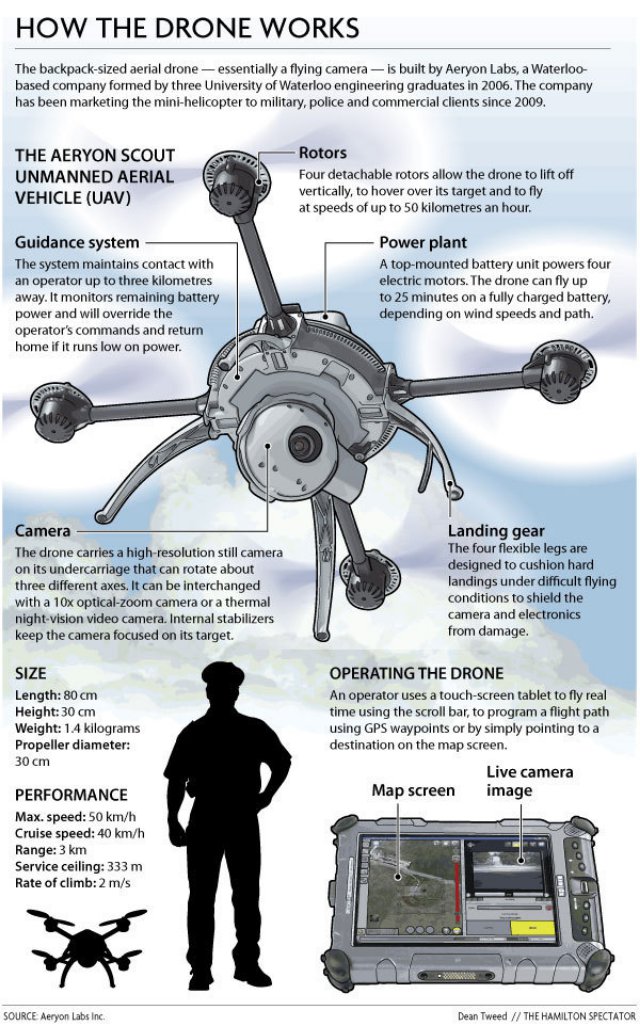[youtube S9y9maDQn2c nolink]
Halton Police in Canada has used it Aeryon Scout on more than 30 missions ranging from photographing crime scenes to using a thermal imaging camera to search for missing persons.
It was used in September to seize 744 marijuana plants growing in a farmer’s field in northeast Milton. It was also used to photograph Burlington’s deadly Via derailment and the fatal Oakville police shooting of Kyle Newman, a short time after he stabbed his estranged wife.
Police are starting use the vehicle to photograph serious crash scenes, including an ongoing research project to see if they can take measurements from the sky to speed up investigations. They also want to begin using the drone in “tactical” situations, for instance if a suspect is on roof or balcony.
In August, Ontario’s privacy commissioner Anne Kavoukian issued a 27-page paper on privacy and drones in which she warned that without careful consideration they “may be extremely invasive.”
READ: Privacy Commissioner warns about drone use (.pdf)
Banks said Halton police follow strict privacy guidelines. In the case of the marijuana bust, police had permission from the farmer to search the property.
“We wouldn’t fly over a farmer’s field without a warrant or permission from the property owner,” Banks said.
The drone is not used on fact-finding missions.
“A lot of people assume it’s a surveillance tool,” Olesen said.
The mini helicopter is piloted from a tablet. On the left side of the screen is Google Maps, which the officer can use to drive the drone by pointing to where it should go. On the right side is the live camera image.
Halton police are also working at getting a “GoPro” camera mount to increase image quality and hope to upgrade to a camera with a 10 times optical zoom.
Police are required to get a special flight operations certificate from Transport Canada, and officers go through a week-long course. Transport Canada also regulates how it’s used, including that the operator must always see the drone.
The programme began as a research project in partnership with the University of Toronto’s forensic sciences programme. Banks said a student, through the mentorship programme, donated 200 hours of service and did a paper and presentation on the viability of the mini helicopter.
Fortunately, around the same time the Canadian Police Research Centre was studying the use of drones and in 2009 ultimately funded the purchase of the Aeryon Scout. The research grant, which also covered training, totalled about $115,000.
At the time they were just the third police service in Canada to get an unmanned aerial vehicle, behind OPP in Kenora and Saskatoon.
Banks says the programme is still primarily a research project, and they continue to work with students.
“The market is really growing,” said Ian McDonald, Vice-President of Product and Marketing for Aeryon Labs, the Waterloo-based company that makes the drones for police and military.
 Military organizations were the earliest to start using the technology and now there is increased interest from police and in other commercial uses. For instance, a team of biologists recently operated the drone from the back of a boat to study wildlife, he said.
Military organizations were the earliest to start using the technology and now there is increased interest from police and in other commercial uses. For instance, a team of biologists recently operated the drone from the back of a boat to study wildlife, he said.
Before heading to the explosives disposal unit, Olesen worked with the marine unit where helicopters were used in searches. He said using a Canadian Forces helicopter costs between $5,000 and $8,000 an hour, not including the crew.
“There are a lot of times where we can’t justify that cost, or the helicopter is not available,” he said, adding that the drone is a cheaper and faster alternative.
Oleson said there are other ways it’s useful, including taking aerial images of schools to have on file. In the event of an emergency, officers can quickly look at them to know the building’s layout.
Source: TheSpec
